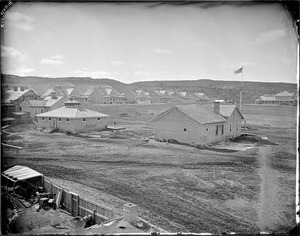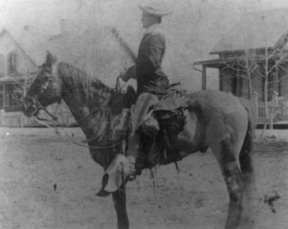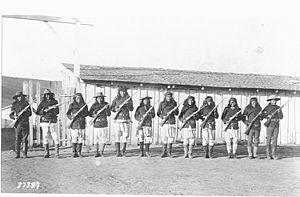Fort Wingate facts for kids
Quick facts for kids Fort Wingate |
|
|---|---|
| McKinley County, near Gallup, New Mexico | |

Fort Wingate in the 1870s
|
|
| Coordinates | 35°06′45″N 107°52′58″W / 35.112466°N 107.882652°W |
| Site information | |
| Controlled by | |
| Condition | ammunition depot, storage facility |
| Site history | |
| Built | 1862 |
| Built by | |
| In use | 1862 - 1993 |
| Battles/wars | Apache Wars Navajo Wars |
| Garrison information | |
| Past commanders |
Kit Carson William Redwood Price |
| Garrison | Navajo Scouts Apache Scouts 4th Cavalry 8th Cavalry 9th Cavalry and 13th Infantry 15th Infantry |
| Occupants | United States Army |
|
Fort Wingate Historic District
|
|
| Lua error in Module:Location_map at line 420: attempt to index field 'wikibase' (a nil value). | |
| Location | NM 400, Fort Wingate, New Mexico |
|---|---|
| Area | 27 acres (11 ha) |
| Built | 1868 |
| NRHP reference No. | 78003076 |
| Significant dates | |
| Added to NRHP | May 26, 1978 |
Fort Wingate was an important military base located near Gallup, New Mexico, in the United States. It was not always in the same spot! There were actually three different places called Fort Wingate in New Mexico.
The first Fort Wingate was active from 1849 to 1862 near Seboyeta, New Mexico. The second was near San Rafael, New Mexico, from 1862 to 1868. This second fort was a starting point for the sad journey known as the Long Walk of the Navajo, when many Navajo people were forced to move from their lands.
The most recent Fort Wingate, which existed from 1868 to 1993, was built where an older fort, Fort Lyon, used to be. It was on Navajo land. Its main job was to manage and "protect" the large Navajo tribe living to the north. Later, the soldiers at the fort also dealt with Apaches to the south. Many Navajo Scouts joined the army at this fort between 1870 and 1890.
During World War II, Fort Wingate became a place where military supplies, especially ammunition, were stored. It was called "Fort Wingate Depot Activity." It even supplied special explosives for the very first atomic bomb test, called the Trinity test. The fort closed in 1993. Today, work is still being done to clean up the land and transfer it to new owners.
Contents
Fort Wingate's Story
The area where Fort Wingate was built is known as Ojo del Oso in Spanish. This means "Eye of the Bear" or "Bear Spring." It was a place with good water and grazing land, often visited by the Navajo people.
Early Years: 1800s
- 1849: The first Fort Wingate was set up as a hay camp near Seboyeta, New Mexico. It was named after Major Benjamin Wingate, a soldier who was hurt in the Battle of Valverde and later died.
- 1860: Another fort, Fort Fauntleroy, was built at Bear Springs (Ojo del Oso). It was an outpost for Fort Defiance. Colonel Thomas T. Fauntleroy named it after himself.
- 1861: Fort Fauntleroy was renamed Fort Lyon. This happened when Colonel Fauntleroy left New Mexico to join the Southern army during the Civil War. Fort Lyon closed in September 1861.
- 1862: Fort Wingate moved to a new spot near San Rafael, New Mexico. This place was also known as "Bikyaya" or "El Gallo." It was designed to hold four groups of soldiers.
- 1864: Colonel Kit Carson was ordered to bring soldiers to this fort to manage the Navajo people.
- 1864–1866: This fort was the starting point for the Long Walk of the Navajo. This was a forced march that moved many Navajo people from their homes.
- 1865: The New Mexico Military District had over 3,000 soldiers, with 135 of them at Fort Wingate.
- 1868: Fort Wingate moved back to the original site of Fort Lyon at Ojo del Oso.
- 1868: Navajo people returning from Bosque Redondo, where they had been held, stayed at Fort Wingate temporarily. Then they moved to the new Navajo Reservation.
- 1873–1886: Soldiers from the fort, along with recruited Navajo Scouts, took part in the Apache Wars.
- 1878: Fort Wingate had 137 soldiers.

-
- 1868–1895: Soldiers from Fort Wingate often helped solve problems between Navajo people and other settlers in New Mexico.
- 1891: Fort Wingate soldiers also helped units in Arizona deal with angry Hopi people.
Modern Era: 1900s and 2000s
- 1907: Two groups of soldiers from the 5th Cavalry went from Fort Wingate to the Four Corners area. They were looking for some armed Navajo. This was the last time the U.S. government sent armed soldiers against the Navajo.
- 1911: A cavalry company from Fort Wingate went to Chaco Canyon. They camped there for several days to calm a possible conflict with the Navajo.
- 1914: During the Mexican Revolution, over 2,000 Mexican soldiers and their families found safety at the fort.
- 1918: Fort Wingate's main focus changed from the Navajo to supporting World War I.
- 1940: Fort Wingate became a large storage area for ammunition. It continued this role through World War II until 1993.
- 1944: Fort Wingate provided 100 tons of high explosives for the Manhattan Project. These were used in the first atomic bomb test, called the Trinity test.
- 1950: Part of the land was given to the Bureau of Indian Affairs for an Indian boarding school.
- 1960–1967: Different types of missiles, like Redstone and Pershing 1, were tested at Wingate.
- 1971: The Department of Defense put Fort Wingate on reserve. It was renamed "Fort Wingate Depot Activity" or FWDA.
- 1988: The government decided to close the fort.
- 1989: Work began to clean up the environment at FWDA.
- January 1993: The fort officially closed.
Fort Wingate Today
Even though the fort's main job ended, the Missile Defense Agency still uses about 6,465 acres of the land. They launch target rockets from here to the White Sands Missile Range.
Since 2005, the New Mexico Environment Department has been working with the Army. They are cleaning up the land. This cleanup involves removing old explosives and other chemicals. Land is also being transferred back to the surrounding community.
Education
There are two Bureau of Indian Education (BIE) boarding schools in the Fort Wingate area. These are Wingate Elementary School and Wingate High School.
Around 1956, the Wingate Elementary dormitory was an old military building. It also housed students from Wingate High. In 1968, the girls' dormitory had 125 girls. At that time, the school strongly discouraged students from speaking Navajo. They wanted students to speak only English. Around 1977, a new building opened that used solar heating.
The local public school district is Gallup-McKinley County Public Schools. Students in the area attend Indian Hills Elementary School, Kennedy Middle School, and Hiroshi Miyamura High School.
Famous People at Fort Wingate
Some important people spent time at Fort Wingate:
- Lieutenant Charles B. Gatewood (1853–1896) led many patrols from Wingate. He later convinced the Apache leader Geronimo to surrender.
- General Douglas MacArthur lived at the fort as a baby, from 1881 to 1885. His father was a Captain in charge of a group of soldiers there.
- General John J. (Black Jack) Pershing served as a Lieutenant at the fort from 1889 to 1890.


